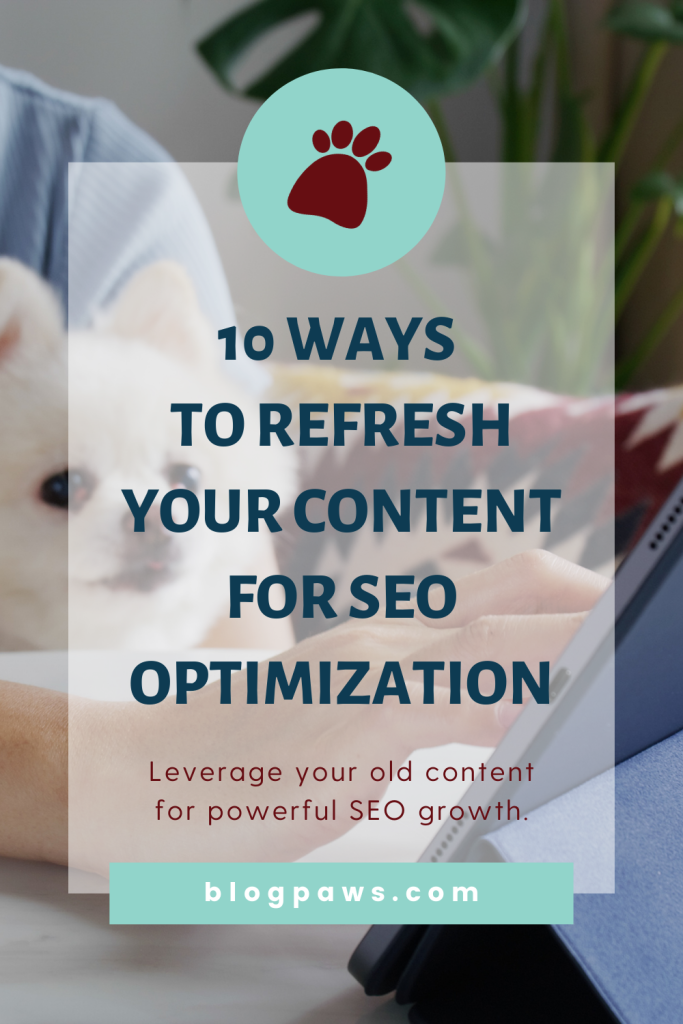10 Ways to Refresh Your Content for SEO Optimization
Are you searching for the secret to ranking on Google and other search engines? While there is no magic button or switch that will transform your content for you, there are several steps that you can take to refresh your content for SEO optimization.
The process of refreshing and updating your content doesn’t have to be difficult. There are many smaller changes and updates that can reward you with results for minimal effort. After all, your time is valuable!
The Importance of Optimizing Content for SEO
You’ve done your keyword research and created quality, SEO-driven blog posts. But you notice that your content isn’t bringing traffic the way that you had hoped. Now what? It’s a struggle that most bloggers will face at one time or another in their journey. The truth is that successful SEO strategies aren’t a one-time effort. Instead, we need to be prepared to track, analyze, and update our content as needed to keep up with the ever-changing algorithms.
Ideally, we would love to see all our posts bringing in new readers on a consistent basis, but that isn’t realistic. Even the most successful blogs and websites have posts that appear to flop after being published. Before you delete any content from your website or write it off as a waste, take a moment to consider refreshing your content and optimizing content for SEO to give it new life.
This same concept can be applied to other forms of web content including product or service sales pages. It’s easy to blame the product or service, feeling as though no one is interested in what we have to offer. However, if you’re not seeing much traffic to a sales page, there’s a good chance that it’s not that people don’t want to buy. Instead, your sales page may not be getting in front of enough people to reach your target customer.
10 Ideas to Refresh Your Content for SEO Optimization
1. Update Statistics and Data
When you first wrote your blog posts, you may have included relevant statistics or data to support the information that you’re sharing. In time, this data becomes old, dated, and irrelevant. A great way to refresh your content is to update this data with the most recent statistics.
If the opinions in your industry have changed with new research and discoveries, update your post to reflect the current stance on different topics. For example, if a supplement is no longer recommended, but your post still recommends it, that is data that needs to be addressed.
2. Add New Research
Another way to update the statistics and data in your blog posts is to find new studies exploring a specific topic. Research studies are a great way to improve the trustworthiness of your posts. This is a great way to stand out as an expert and reputable source of information in your field, even if you don’t have any credentials to establish your authority.
3. Upgrade to Better Quality Photos or Videos
Have your photography or videography skills improved since you first published your post? Have you recently purchased a subscription to a high-quality stock photography site? Upgrading the visuals in your post is a great way to give your content a facelift.
Adding a video is also a great way to improve your bounce rate and increase the time that readers are spending on your website. This signals to Google that your content is providing value to those that click through to your website.
Try recording a video and uploading it on YouTube that covers some, or all, of the content in your blog post. When you publish this on YouTube, be sure to link back to your post. This is a great way to reach potential blog readers in a new place, increasing traffic while also adding value to the blog post itself.
Design an infographic and add it to your blog post. Visual components like these are highly shareable, which can attract backlinks from other sites in your niche.
Don’t forget to add alt text to any visual elements. This will help to make your website more accessible and work towards improving the overall organic search ranking of your site.
4. Incorporate Expert Quotes
Similar to including research studies, by adding expert quotes to your blog posts you can boost the authority of the content that you’re sharing. For example, if you are writing a post about a dog medical condition, a quote from a veterinarian will help to build trust in the information that you are sharing.
Credibility, whether it’s due to your own experience and credentials or through incorporating the authority of an expert in the field, will help to improve your content for SEO by boosting your quality rating. When assessing content for E.A.T. (Expertise, Authoritativeness, and Trustworthiness), these updates go a long way!
5. Conduct and Apply Keyword Research
One of the better-known ways to optimize content for SEO is to do keyword research. But, if you’re newer to SEO optimization, what exactly does that popular phrase mean? The term “keyword research” refers to the process of identifying the words or phrases that people are actively searching for, and how difficult it would be to rank for them.
The goal is to find a balance between traffic levels and difficulty. A keyword with a lot of traffic is great, but that traffic isn’t going to help you if the only pages ranking are major brands and well-known corporations. On the other hand, an easy to rank keyword isn’t going to help bring traffic to your website even if you’re in the top space if there is no one searching for it.
If you did keyword research when first writing your blog post, don’t skip this point!
There are always improvements to consider. Check the keywords you originally focused on and see if there are any other opportunities to optimize your content further. You may also want to choose different keywords if you find that there are better options available.
6. Add a Call to Action
When trying to identify the best ways to optimize your content for SEO, many people will overlook the power of a well-crafted call to action (CTA). The purpose of your CTA is to guide the reader onto the next part of their journey, whatever that may be. They could encourage engagement by asking for comments or request an email address for your mailing list.
Not only does this help to increase revenue for those of you that are selling products or services, but it’s also a great way to build a loyal community. Incorporate your keyword or phrase into your CTA to further tie in your SEO efforts.
7. Fix and Update Links
Fixing broken links should be part of your ongoing website maintenance, but sometimes life happens. Quality external links have an impact on your ranking, but so do broken links. Take some time to clean up links by removing or updating them. This is also a great opportunity to identify opportunities for new links in your content. Make sure that you are only adding links to high-quality, relevant content that fits with the information that you are sharing.
8. Build Out Internal Linking
Another important part of your linking strategy, internal linking refers to the links that exist between your blog posts. This helps to create content clusters, connecting multiple posts within a single content theme. For example, if you’re updating a post that discusses the importance of physical conditioning for dog sports, it could link to content that you’ve published about individual sports or canine sporting gear.
Internal linking is a great way to show Google’s algorithm (and those used by other search engines) that you are an expert in your niche by highlighting how much knowledge you are sharing. It also makes it easier for readers to find their way to other relevant content that they may be interested in, increasing the time spent on your website.
9. Consolidate Content Where It Makes Sense
When working your way through your library of content, take note of any duplicate content. This could be any posts that discuss the same topic or a similar enough topic that it’s competing for the same keywords and phrases. Known as keyword cannibalization, many SEO experts warn that this can hinder the ability for any of the blog posts or pages in question to rank.
If you notice this, the easiest solution is to consolidate these posts into a single, optimized blog post. You can use the highest-ranking of the URLs or the one that best fits your new post. If you have Pinterest pins or other traffic opportunities directing people to the original posts, use a 301 redirect to send them to the new content.
You can also consolidate content when you notice that you have multiple posts that are low or mid-performing, bringing them together to create better, more comprehensive content. As Google and other search engines prioritize the highest quality content, this will help your post rank.
10. Refresh Your Meta Description
Your meta description is the summary of your website that may be shown on Google when your website shows up in search results. There isn’t a lot that you can do here in terms of optimizing content for SEO, except for including your primary keyword in the description. But this short snippet can have a significant impact on the number of people that click on your link.
The goal is to write a brief description of your article that will draw people in and create interest in wanting to read your content. If you have an article ranking well for a keyword with traffic to capture, but doesn’t appear to be bringing any of this traffic to your website, your title and meta description are the two areas to focus on.
It should be noted, however, that Google may not use your created meta description. Instead, they may create their own summary. So, you may not have complete control over this point.

The Next Steps to Optimize Content
After you’ve worked through optimizing your content for SEO, it’s time for the next important step – analyzing how it performs with these new updates. It can be tempting to check your data daily, but for most people, that’s just going to add stress to the situation. Instead, give it some time for the search engine bots to recrawl your updated posts and apply the changes to their ranking. Most experts recommend waiting 3-4 months before expecting to see a noticeable impact.
There are many tools that you can use to track the performance of your blog posts.
For the most accurate traffic results, Google Analytics allows you to go right to the source. This will allow you to see how many people are visiting your website, how many of those visitors are coming to your site through an organic search and which blog posts or product sales pages they are visiting. With all this information, you can identify which blog posts are bringing traffic to your website and which are falling short.
The other part of the puzzle to consider is the keyword ranking. There are many tools to track how you are performing in search such as Ahrefs, SEMRush, Ubersuggest, KeySearch, and Google Search Console. Most of these tools do come at a cost to unlock their full potential, but those with paid plans often also offer a free option that you can use to get started.
Most experts recommend checking your content and updating as needed at least once a year. Updating your content for SEO is an ongoing project, a living, breathing cycle that is going to continue for the life of your website. There is never going to be a time when it’s “done”. But this isn’t a bad thing – it means that there are always opportunities for growth and further success!
The process of updating and refreshing content may seem overwhelming at first, but it will get easier as you find your own process and flow. Select 1 or 2 articles that could use a little help. Experiment with the options that we have listed or find other opportunities for improvement. When you start to see the results of your efforts, it will be worth the work!
Do you currently take time to optimize your content for SEO? If so, what details do you focus on most? If not, what is holding you back?
About the Author: Britt Kascjak, BlogPaws Director of Content & SEO, is an award-winning freelance writer whose background in digital and social media marketing spans 15+ years. She’s been a content creator in the pet industry for 9+ years with her own blogs: Shed Happens, The Kas Pack, and Lucifer the Rescue Pup where she shares her life and outdoor adventures with her 2 dogs and 3 cats. Read more…






One Comment